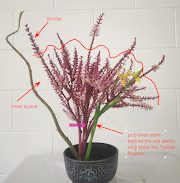Four Ikebana Elements Level 2.7 - Space 2 (13th August 2022)
Ikebana Aesthetics Program - Four Ikebana Elements Level 3 is not open for registration
Learn about the four Ikebana elements online from February 2021. Beginners welcome. 日本からのご参加歓迎いたします。
Video Tutorial: See Above. Please follow our site or subscribe to our YouTube Channel.
When: (Melbourne, Australia Time) Check your local time.
2:00 - 2:30 PM, 13 August 2022 Space 2
2:00 - 2:30 PM, 27 August 2022 Colour 2
2:00 - 2:30 PM, 27 August 2022 Colour 2
Facilitators: Shoso Shimbo & Shoan Lo
Who can Join: Anyone, regardless of ikebana school, stage of learning or country of residence. Beginners welcome. You must be familiar with Zoom. Sessions will be conducted in English.
How Many Participants: Up to 6 for each session
How Much: Aus $60 to join the program of 4 sessions.
Level 3 Starting Soon.
Overview
In Space 1 we talked about the importance of Ma (negative space) in Japanese art, in particular Ikebana. You can create negative space around, within, or between objects in Ikebana.
Although we are focusing on Ma created by the branches or other materials in Ikebana work at this stage, we also need to pay attention to the Ma between an Ikebana work and its surroundings.
As we mentioned in Space 1 not all negative spaces are Ma in Ikebana. We can recognise Ma only when the negative space becomes poetic. Ma helps all elements become unified into a single artwork.
In Space 2 we make two Nageire arrangements, and create a negative space between them. Make it the largest negative space in your work. Then, meditate on the size of the negative space by changing the positions of your two arrangements. Can you find the moment when the negative space becomes most effective?
For more about Space in Ikebana, refer to a short essay, "Introduction to Ikebana Aesthetics" by Dr Shoso Shimbo (available shortly in English & Japanese).
Objectives in Space 2
1. Create a single negative space in the centre of your design. We will be making an arrangement consisting of two Nageire arrangements.
2. Learn how to interpret basic ikebana diagrams.
3. Learn Nageire techniques.
4. Change the gap between two arrangements. Focus on the largest negative space in your work and notice the effect as you change the position of the two parts of your work.
In Space 2 we make two Nageire arrangements, and create a negative space between them. Make it the largest negative space in your work. Then, meditate on the size of the negative space by changing the positions of your two arrangements. Can you find the moment when the negative space becomes most effective?
For more about Space in Ikebana, refer to a short essay, "Introduction to Ikebana Aesthetics" by Dr Shoso Shimbo (available shortly in English & Japanese).
Objectives in Space 2
1. Create a single negative space in the centre of your design. We will be making an arrangement consisting of two Nageire arrangements.
2. Learn how to interpret basic ikebana diagrams.
3. Learn Nageire techniques.
4. Change the gap between two arrangements. Focus on the largest negative space in your work and notice the effect as you change the position of the two parts of your work.
What You Need
1. Secateurs (scissors may be handy too)
2. A down-stick / branch
3. Container - suitable for nageire.
4. Flower/plant materials: (Flower materials are a guide only. You can choose any similar materials as long as you focus on the topic.)
a. five or six branches -tecoma
b. main flowers - roses
c. a few additional flowers (optional) - veronica
How to Make It / Your Task
You will receive Space 2 Session Notes with step-by-step instructions for making your arrangement after your payment. Our free video and the Session Notes will help you make your ikebana work.
How to Book & Participate:
1. Please visit our Booking Calendar to book. Please check our cancellation policy. Also please visit our orientation page to find how to use Zoom Ikebana Dojo effectively.
2. Upon receipt of your payment, you will receive booking confirmation with an invitation link to the Zoom session.
3. You will receive Session Notes about 5 days before the session. Please contact us if don’t hear from us.
4. Make your ikebana work before the session. Take a photo of your work (less than 0.5 Meg.) and send to ikebana.dojo@gmail.com at least 24 hours before the session starts if you want detailed feedback.
5. Alternatively, you can share the photo of your work during the session. Find a way to share your file using Zoom.
6. Join the session. Prepare your work and its photo.
Each person has about four minutes for show and tell, and to receive feedback from our facilitator and other students. Our facilitator will make comments on your photo. Please adjust your work after the session.
7. Enjoy show and tell by other students before and after your own presentation. Group interaction is helpful for your learning. Works by others can inspire you.
8. Rework your arrangement soon after the session. Share a photo of your revised work to Ikebana Gallery Facebook Page. See how to apply for the 2021 Ikebana Gallery Award if you are a student.
9. If you would like to join Zoom Ikebana Dojo again, please visit our pages on Ikebana Aesthetics Program or Special Program.
More Sample Works


























